The Automotive Airbag Controller Unit Market is estimated to be valued at USD 8.2 billion in 2025 and is projected to reach USD 15.6 billion by 2035, registering a compound annual growth rate (CAGR) of 6.6% over the forecast period. This expansion, supported by a solid CAGR of 6.6%, is driven by rising regulatory mandates for vehicle safety, the integration of advanced airbag systems, and the growth of electric and connected vehicles. During the first five-year phase (2025–2030), the market increases from USD 8.2 billion to USD 11.3 billion, adding USD 3.1 billion, or 42% of the total incremental growth, resulting in a 5-year multiplier of 1.38x. The second half (2030–2035) delivers USD 4.3 billion, representing 58% of incremental gains, as adoption accelerates with higher penetration of premium vehicles featuring multi-stage airbags and enhanced occupant detection systems. Annual increments rise from USD 0.5 billion in early years to USD 1.0 billion toward 2035, signaling steady momentum as advanced driver-assistance systems (ADAS) and autonomous driving platforms necessitate sophisticated safety architectures. Manufacturers prioritizing electronic integration, lightweight design, and predictive safety algorithms will be best positioned to capture value in this USD 7.4 billion growth window, particularly in Asia-Pacific and North America.
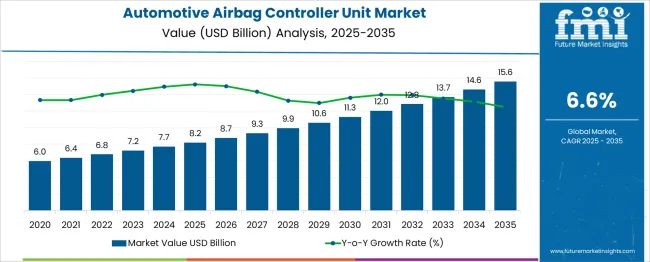
| Metric | Value |
|---|---|
| Automotive Airbag Controller Unit Market Estimated Value in (2025 E) | USD 8.2 billion |
| Automotive Airbag Controller Unit Market Forecast Value in (2035 F) | USD 15.6 billion |
| Forecast CAGR (2025 to 2035) | 6.6% |
The automotive airbag controller unit market holds a substantial role within several automotive safety and electronics sectors. In the automotive safety systems market, its share is approximately 10–12%, as it represents a key component within passive safety solutions alongside seatbelts and sensors. Within the automotive electronics market, it accounts for about 4–5%, given the dominance of infotainment, engine control units, and power electronics. In the passive safety components market, the share is significant at nearly 25–28%, as airbag control units are integral to crash safety systems. For the advanced driver assistance systems (ADAS) market, the share is relatively small at 2–3%, since ADAS primarily includes active safety technologies such as lane-keeping and adaptive cruise control. In the automotive control modules market, it contributes around 6–7%, as this category includes multiple control systems for powertrain, body, and comfort functions.
Growth is fueled by stricter global vehicle safety regulations, increasing consumer awareness, and the integration of multi-stage airbags in vehicles. Advancements such as AI-based crash detection algorithms, compact ECU designs, and improved communication with other safety modules are enhancing system reliability. With the expansion of connected and autonomous vehicles, airbag controller units are expected to maintain a vital role, strengthening their position across these parent markets.
The demand for smarter, faster, and more responsive safety systems has encouraged automakers to integrate advanced airbag controllers capable of managing multiple sensor inputs in real time.
As vehicle production increases, especially in emerging economies, the need for scalable and cost-effective airbag control systems is growing in parallel. Automotive OEMs are also investing heavily in improving crash detection accuracy and multi-stage deployment capabilities, further enhancing the role of the airbag control unit in overall safety architecture.
The trend toward electrification and intelligent connected vehicles has elevated the importance of software-driven, highly reliable electronic control units that can coordinate with other advanced driver-assistance systems. As governments push for safer transport infrastructure and vehicle manufacturers adopt zero-fatality goals, the Automotive Airbag Controller Unit market is set to witness consistent and technology-driven expansion over the forecast period..
The automotive airbag controller unit market is segmented by type, technology, vehicle, sales channel, and geographic regions. The automotive airbag controller unit market is divided by type into Frontal airbags, Side airbags, Curtain airbags, Knee airbags, and Pedestrian airbags. In terms of technology, the automotive airbag controller unit market is classified into Basic, Advanced, and Integrated ADAS. Based on the vehicle, the automotive airbag controller unit market is segmented into Passenger vehicles and Commercial vehicles. The automotive airbag controller unit market is segmented by sales channel into OEM and Aftermarket. Regionally, the automotive airbag controller unit industry is classified into North America, Latin America, Western Europe, Eastern Europe, Balkan & Baltic Countries, Russia & Belarus, Central Asia, East Asia, South Asia & Pacific, and the Middle East & Africa.
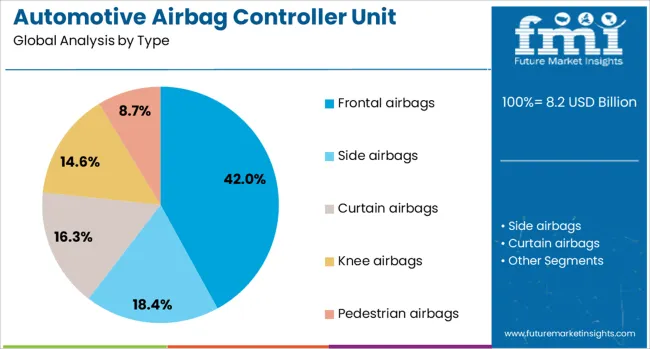
The frontal airbag type segment is projected to contribute 42% of the revenue share in the Automotive Airbag Controller Unit market in 2025, positioning it as the leading segment by type. This dominance has been driven by regulatory mandates in both developed and developing nations requiring frontal airbags as standard equipment in passenger vehicles. The segment’s prominence is further reinforced by the high incidence of frontal collisions, where immediate and effective protection for the driver and front passenger is essential.
Advanced crash sensing and deployment algorithms, controlled by the airbag controller unit, have significantly improved the reliability and responsiveness of frontal airbag systems. Automakers continue to prioritize this segment in vehicle designs due to its proven safety benefits and consumer expectations for standard frontal protection.
Additionally, the maturity of frontal airbag technologies has enabled cost optimization without compromising performance, making it accessible across a wide spectrum of vehicle categories. The increasing focus on occupant safety and standardized protection systems is expected to sustain the segment’s leadership..
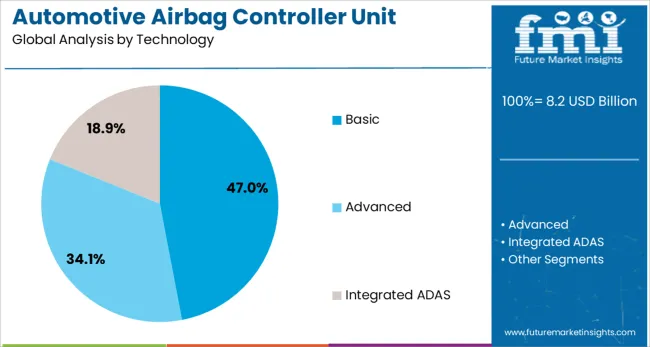
The basic technology segment is expected to account for 47% of the Automotive Airbag Controller Unit market revenue share in 2025, making it the leading segment by technology. This growth has been supported by the widespread adoption of foundational airbag control solutions in entry-level and mid-range vehicles. Despite advancements in adaptive and intelligent safety technologies, basic airbag controllers remain integral to cost-sensitive automotive segments due to their proven functionality and affordability.
These units typically manage the deployment of frontal airbags with essential crash detection sensors, delivering effective safety performance under standard collision scenarios. Their simplicity and reliability have positioned them as the preferred choice in markets where cost efficiency and compliance with minimum safety standards are paramount.
As vehicle ownership expands in price-sensitive regions, the demand for basic yet compliant safety systems remains strong. Furthermore, the ease of integration and low production cost of basic controllers continue to drive their market share across global automotive production lines..
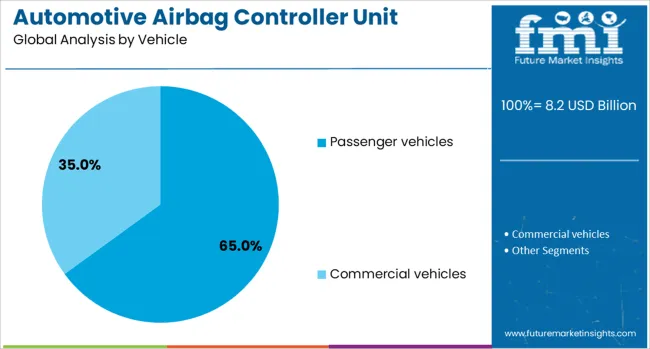
The passenger vehicles segment is projected to hold 65% of the Automotive Airbag Controller Unit market revenue share in 2025, making it the leading segment by vehicle category. The growth of this segment has been largely attributed to rising vehicle ownership, expanding middle-class demographics, and increasing safety awareness among consumers worldwide.
Passenger vehicles, especially sedans, hatchbacks, and sport utility vehicles, are being equipped with multi-airbag systems managed by centralized control units that ensure coordinated and timely deployment. The segment's expansion has also been supported by government mandates requiring airbag systems in all new passenger vehicles, particularly in high-growth regions across Asia and Latin America.
Original equipment manufacturers are prioritizing investment in airbag technology to meet both regulatory and consumer safety expectations, driving increased integration of advanced controller units. The adaptability of airbag control systems to various passenger vehicle models and their role in enhancing occupant protection have reinforced this segment’s dominant position in the overall market..
The aircraft airbag controller unit market is expanding due to increasing global aircraft deliveries, stricter safety regulations, and rising air travel. Demand for lightweight, high-performance control systems has been driven by both commercial fleet renewals and defense procurements. Growth is supported by increasing adoption of integrated safety architectures and multi-sensor crash detection systems. However, high certification costs, regulatory hurdles, and constrained supplier flexibility continue to limit innovation. Overall, strong momentum is expected from rising fleet sizes, evolving safety frameworks, and OEM focus on efficiency and reliability across aviation segments.
Major growth in the aircraft airbag controller unit segment has been driven by increasing aircraft production and tightening safety norms. In 2024 and 2025, commercial airlines ordered new narrow‑body and wide‑body aircraft, which required advanced controller units for frontal, side, curtain, and knee airbag systems. Military procurement in North America and Asia-Pacific further boosted uptake. The demand for modular electronic control units capable of supporting multiple airbag types has been elevated to satisfy stringent certification protocols and ensure passenger protection in complex crash scenarios.
Substantial opportunity is seen in development of lightweight electronic control units optimized for electric and hybrid aircraft platforms. In 2025, newer models of controller units offering enhanced crash sensing and seamless integration with digital flight-control systems were introduced. Demand for units compatible with over-the-air update capability and advanced driver assistance interoperability was driven by autonomous and connected aircraft platforms. Aircraft OEMs have been favoring suppliers that can deliver compact units with lower weight and minimal maintenance requirements.
Emerging trends include sensor fusion integration and real-time monitoring for diagnostic insights. In 2024, airbag controller units embedding multiple sensor types—accelerometers, pressure sensors, gyroscopes—began being deployed to enhance crash accuracy. Remote diagnostics and predictive maintenance features have been introduced in certain military and commercial aircraft fleets, enabling early fault detection. Modular filter designs and composite material housings used in controller units have also gained traction among suppliers aiming to deliver longer service intervals and reduce downtime in scheduled maintenance cycles.
Market restraints are linked to the high expense of certification and the complexity of approval processes. In 2024–2025, delays in obtaining regulatory compliance for new ECU designs—especially those integrating novel sensor arrays—slowed market introduction. The cost of qualified aerospace-grade materials and specialized components raised production budgets for smaller suppliers. Disruptions in global supply chains for microelectronics, particularly in the Asia‑Pacific region, further impacted unit delivery schedules. These factors underscore the need for robust quality systems and strategic supplier partnerships to maintain a competitive presence.
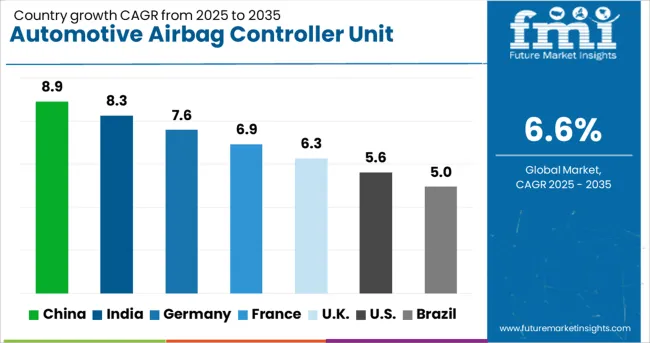
| Country | CAGR |
|---|---|
| China | 8.9% |
| India | 8.3% |
| Germany | 7.6% |
| France | 6.9% |
| UK | 6.3% |
| USA | 5.6% |
| Brazil | 5.0% |
The global automotive airbag controller unit market is projected to grow at a 6.6% CAGR during 2025–2035. China leads with 8.9% CAGR, driven by rising passenger vehicle production and stricter occupant safety regulations. India follows at 8.3%, supported by mandatory airbag installation norms and expanding automotive manufacturing capacity. Germany posts 7.6% CAGR, benefiting from high-end vehicle demand and advanced safety integration in EV platforms. The UK grows at 6.3%, while the United States records 5.6%, reflecting steady adoption in a mature automotive landscape focused on premium vehicles and regulatory compliance. Asia-Pacific dominates growth due to aggressive safety mandates and increasing consumer awareness, whereas developed markets prioritize innovation in smart, sensor-driven airbag control systems.
China is forecasted to grow at 8.9% CAGR, leading global demand for automotive airbag controller units. Rapid passenger car production, combined with tightening safety standards, has accelerated adoption of multi-stage airbag systems. The rise in EV manufacturing and premium vehicle penetration further strengthens demand for advanced control units integrated with ADAS (Advanced Driver Assistance Systems). Domestic OEMs partner with global Tier-1 suppliers to develop smart controllers capable of real-time crash data processing and occupant detection. Integration of IoT-enabled monitoring and predictive algorithms is emerging as a major trend in next-generation vehicles.
The market in India is expected to grow at 8.3% CAGR, supported by stringent safety regulations mandating dual airbags in all passenger vehicles and additional requirements for high-end models. Rapid automotive production and rising sales of compact SUVs create strong demand for airbag controller units. Domestic suppliers expand their portfolio with cost-effective controllers, while international players introduce adaptive solutions integrated with seat belt pre-tensioners. Increasing penetration of electric two-wheelers and small EV cars drives interest in lightweight and compact airbag modules designed for urban mobility platforms.
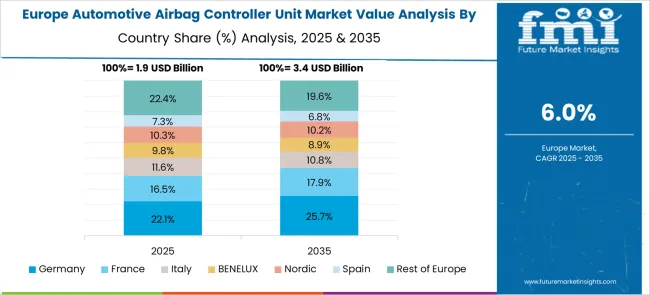
Germany posts a 7.6% CAGR, driven by luxury car demand, advanced safety systems, and EV adoption. German OEMs lead in integrating smart airbag controllers with ADAS functionalities, ensuring rapid deployment during high-speed collisions. Tier-1 suppliers invest heavily in R&D to develop controllers with advanced crash detection sensors, occupant classification, and predictive safety logic. The introduction of automated driving features in premium vehicles further emphasizes intelligent controller solutions. Compliance with Euro NCAP’s evolving safety benchmarks accelerates innovation in software-driven control systems.
The United Kingdom market is projected to grow at 6.3% CAGR, supported by rising demand for high-end passenger cars and regulatory initiatives emphasizing occupant safety. Advanced safety features in premium and electric vehicles fuel demand for multi-channel controller units capable of managing side, curtain, and knee airbags. Automotive manufacturers invest in predictive safety algorithms to align with semi-autonomous driving technologies. Increased vehicle exports to EU markets necessitate compliance with strict crash safety standards, pushing local suppliers to innovate with compact, software-driven controllers.
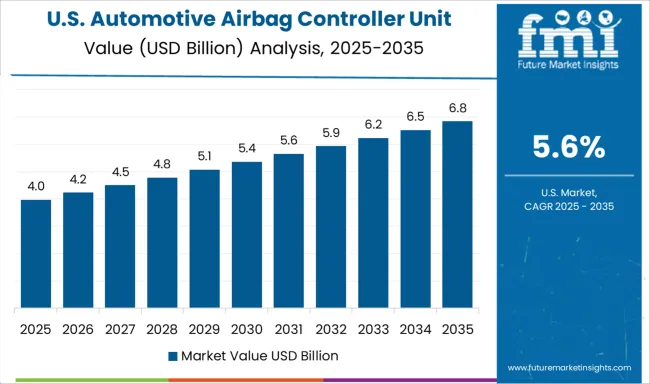
The United States is forecasted to grow at 5.6% CAGR, reflecting moderate but steady adoption in a mature automotive landscape. Growth is driven by safety upgrades in mass-market vehicles, high penetration of SUVs, and advanced restraint systems in premium models. Leading suppliers are developing next-gen airbag controllers featuring IoT connectivity, over-the-air software updates, and enhanced diagnostic capabilities. Rising consumer preference for vehicles with Level 2 and Level 3 autonomous features underscores the need for intelligent control systems capable of interfacing with ADAS and vehicle telematics.
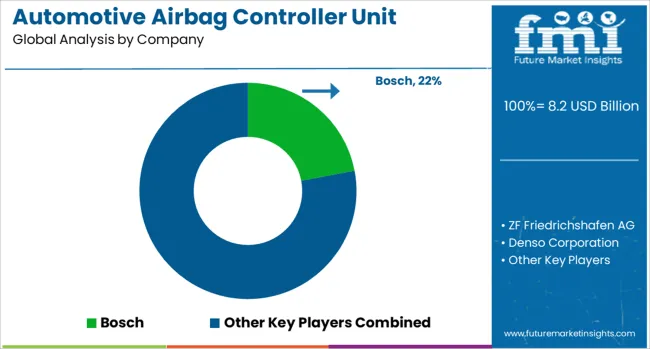
The automotive airbag controller unit market is moderately consolidated, with Bosch recognized as a leading player due to its advanced safety electronics and strong integration capabilities in vehicle restraint systems. The company offers high-performance airbag ECUs designed for rapid crash detection, precise deployment, and compliance with stringent safety standards across global markets.
Key players include ZF Friedrichshafen AG, Denso Corporation, Continental AG, Aptiv PLC, Hyundai Mobis, Veoneer Inc., and Mitsubishi Electric Corp. These companies develop sophisticated airbag controller units with multi-sensor integration, fault diagnostics, and adaptability for multiple airbags, ensuring enhanced occupant safety. Their solutions are tailored for various vehicle categories, from passenger cars to commercial vehicles, supporting global automotive OEMs.
Market growth is driven by increasing adoption of advanced passive safety systems, rising vehicle production, and strict regulatory requirements for crash protection. Leading manufacturers are focusing on innovations such as integration with active safety systems, lightweight designs, and compatibility with electric and autonomous vehicles. Emerging trends include the development of AI-enabled crash prediction systems, over-the-air (OTA) update capabilities, and scalable platforms to support different vehicle architectures. Asia-Pacific dominates the market due to high automotive production, while Europe and North America lead in advanced safety technology adoption and regulatory enforcement.
| Item | Value |
|---|---|
| Quantitative Units | USD 8.2 Billion |
| Type | Frontal airbags, Side airbags, Curtain airbags, Knee airbags, and Pedestrian airbags |
| Technology | Basic, Advanced, and Integrated ADAS |
| Vehicle | Passenger vehicles and Commercial vehicles |
| Sales Channel | OEM and Aftermarket |
| Regions Covered | North America, Europe, Asia-Pacific, Latin America, Middle East & Africa |
| Country Covered | United States, Canada, Germany, France, United Kingdom, China, Japan, India, Brazil, South Africa |
| Key Companies Profiled | Bosch, ZF Friedrichshafen AG, Denso Corporation, Continental AG, Aptiv PLC, Hyundai Mobis, Veoneer Inc., and Mitsubishi Electric Corp. |
| Additional Attributes | Dollar sales by airbag type (frontal, side, curtain, knee, pedestrian) and technology (basic, advanced ADAS-integrated). Asia-Pacific dominates, with North America growing via EV and autonomous adoption. Buyers seek OTA-capable ECUs, sensor fusion, and lightweight designs. Innovations include blockchain-secured diagnostics, eco-friendly biodegradable housings, and AI-driven deployment algorithms for enhanced crash response. |
The global automotive airbag controller unit market is estimated to be valued at USD 8.2 billion in 2025.
The market size for the automotive airbag controller unit market is projected to reach USD 15.6 billion by 2035.
The automotive airbag controller unit market is expected to grow at a 6.6% CAGR between 2025 and 2035.
The key product types in automotive airbag controller unit market are frontal airbags, side airbags, curtain airbags, knee airbags and pedestrian airbags.
In terms of technology, basic segment to command 47.0% share in the automotive airbag controller unit market in 2025.






Our Research Products

The "Full Research Suite" delivers actionable market intel, deep dives on markets or technologies, so clients act faster, cut risk, and unlock growth.

The Leaderboard benchmarks and ranks top vendors, classifying them as Established Leaders, Leading Challengers, or Disruptors & Challengers.

Locates where complements amplify value and substitutes erode it, forecasting net impact by horizon

We deliver granular, decision-grade intel: market sizing, 5-year forecasts, pricing, adoption, usage, revenue, and operational KPIs—plus competitor tracking, regulation, and value chains—across 60 countries broadly.

Spot the shifts before they hit your P&L. We track inflection points, adoption curves, pricing moves, and ecosystem plays to show where demand is heading, why it is changing, and what to do next across high-growth markets and disruptive tech

Real-time reads of user behavior. We track shifting priorities, perceptions of today’s and next-gen services, and provider experience, then pace how fast tech moves from trial to adoption, blending buyer, consumer, and channel inputs with social signals (#WhySwitch, #UX).

Partner with our analyst team to build a custom report designed around your business priorities. From analysing market trends to assessing competitors or crafting bespoke datasets, we tailor insights to your needs.
Supplier Intelligence
Discovery & Profiling
Capacity & Footprint
Performance & Risk
Compliance & Governance
Commercial Readiness
Who Supplies Whom
Scorecards & Shortlists
Playbooks & Docs
Category Intelligence
Definition & Scope
Demand & Use Cases
Cost Drivers
Market Structure
Supply Chain Map
Trade & Policy
Operating Norms
Deliverables
Buyer Intelligence
Account Basics
Spend & Scope
Procurement Model
Vendor Requirements
Terms & Policies
Entry Strategy
Pain Points & Triggers
Outputs
Pricing Analysis
Benchmarks
Trends
Should-Cost
Indexation
Landed Cost
Commercial Terms
Deliverables
Brand Analysis
Positioning & Value Prop
Share & Presence
Customer Evidence
Go-to-Market
Digital & Reputation
Compliance & Trust
KPIs & Gaps
Outputs
Full Research Suite comprises of:
Market outlook & trends analysis
Interviews & case studies
Strategic recommendations
Vendor profiles & capabilities analysis
5-year forecasts
8 regions and 60+ country-level data splits
Market segment data splits
12 months of continuous data updates
DELIVERED AS:
PDF EXCEL ONLINE
Automotive Direct Liquid Cooling IGBT Module Market Size and Share Forecast Outlook 2025 to 2035
Automotive Hoses and Assemblies Market Size and Share Forecast Outlook 2025 to 2035
Automotive Network Testing Market Size and Share Forecast Outlook 2025 to 2035
Automotive Performance Part Market Size and Share Forecast Outlook 2025 to 2035
Automotive Carbon Ceramic Brake Market Size and Share Forecast Outlook 2025 to 2035
Automotive Camshaft Market Size and Share Forecast Outlook 2025 to 2035
Automotive Stamping Industry Analysis in India Size and Share Forecast Outlook 2025 to 2035
Automotive Cylinder Liner Market Size and Share Forecast Outlook 2025 to 2035
Automotive Roof Rails Market Size and Share Forecast Outlook 2025 to 2035
Automotive Active Safety System Market Size and Share Forecast Outlook 2025 to 2035
Automotive Diagnostic Scan Tool Market Size and Share Forecast Outlook 2025 to 2035
Automotive Test Equipment Market Size and Share Forecast Outlook 2025 to 2035
Automotive Dynamic Map Data Market Size and Share Forecast Outlook 2025 to 2035
Automotive Green Tires Market Size and Share Forecast Outlook 2025 to 2035
Automotive E-Tailing Market Size and Share Forecast Outlook 2025 to 2035
Automotive Interior Market Forecast Outlook 2025 to 2035
Automotive Key Market Size and Share Forecast Outlook 2025 to 2035
Automotive Appearance Chemical Market Forecast and Outlook 2025 to 2035
Automotive Seating Market Forecast and Outlook 2025 to 2035
Automotive Domain Control Module Market Forecast and Outlook 2025 to 2035

Thank you!
You will receive an email from our Business Development Manager. Please be sure to check your SPAM/JUNK folder too.
Chat With
MaRIA